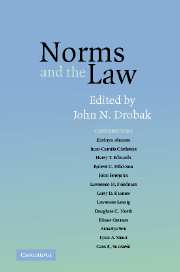11 - Normative Evaluation and Legal Analogues
Published online by Cambridge University Press: 05 June 2012
Summary
Custom, that unwritten law
By which the people keep even kings in awe.
So wrote Charles Davenant, in Circe, about three hundred years ago. There are not many kings left in the world, but custom, in various forms, does still link closely with law. Indeed, norms and laws are intimately connected and influence each other. The influences work in both directions.
Norms have an impact on the actual rules of operation in a society in at least two distinct ways. First, the conduct and behavior of people are influenced, to varying extents, by the established norms in a society. Norms can impose obligations and constraints which work like law, and this is perhaps the most direct manifestation of norms as “unwritten law” to which Charles Davenant referred. At the very least, norms can supplement legal rules (the “written law,” as it were) that are in force.
To consider an often discussed example, the enforcement of economic contracts can be made much easier if the power of legal force is supplemented by appropriately conformist behavior. Voluntary compliance can, in this sense, play an auxiliary but important part in the enforcement of contracts, for which policing may be the last resort. This recognition, incidentally, is not in conflict with Douglass North's critical argument, which I find entirely persuasive, that “neither self-enforcement by parties nor trust can be completely successful,” and that “a coercive third party is essential” for the enforcement of contracts.
- Type
- Chapter
- Information
- Norms and the Law , pp. 247 - 266Publisher: Cambridge University PressPrint publication year: 2006
- 2
- Cited by



